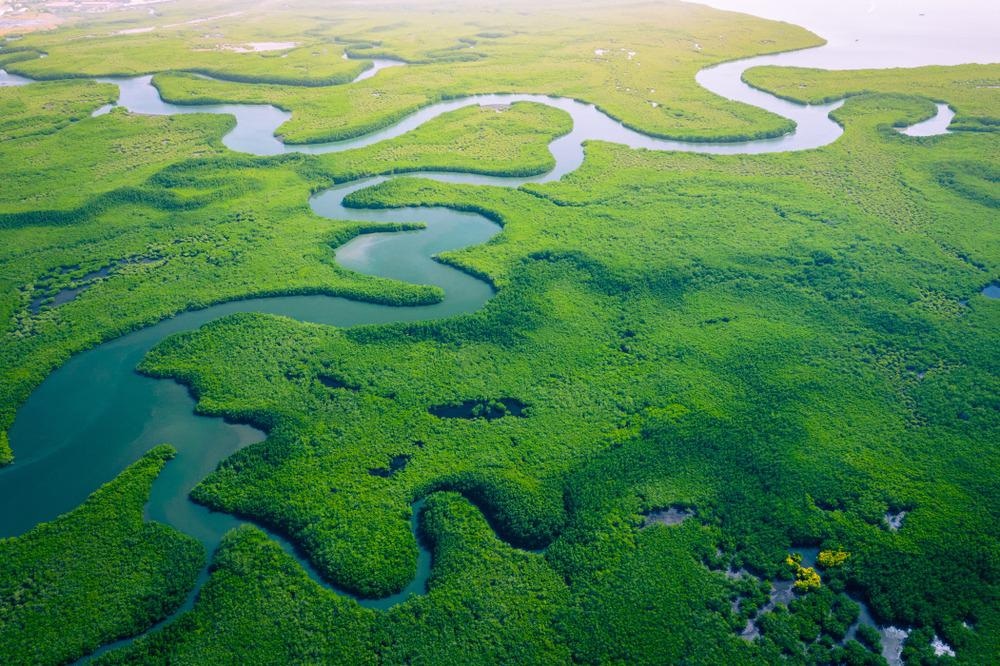The oceans produce more than half of the world's oxygen and are responsible for absorbing one-quarter of the carbon dioxide that humans create. The oceans are also home to an estimated 500,000–10 million marine species. It is fundamental to the planet's future that we protect the oceans; however, it faces several significant challenges such as pollution, reduction in biodiversity, and numerous threats posed to coastal communities.
Mangroves may not immediately be considered part of the ocean, but these coastal trees are vital players in supporting diverse coastal ecosystems, particularly in tropical and subtropical ocean regions. The world's coral reef systems rely on mangroves to provide shelter for young fish and provide protection from sediment and nutrients. These trees, of which there are around 80 different species, provide a line of defense between the land and sea, are responsible for absorbing carbon dioxide, and contribute to both economic and food security for coastal communities.
While mangroves are vital to oceanic health, they are under threat. Here, we discuss their importance, why we are losing our mangroves, and what can be done.
Mangroves: how they help the ocean
Why mangroves are the nucleus of many coastal habitats
The United Nations Environment Programme (UNEP) recently released research highlighting how mangroves are essential to global and local economies. Mangroves support fisheries, provide food security for coastal communities, and protect the world's coastlines.
Mangroves impact many millions of people and the nature that exists in coastal regions. They detoxify pollutants that arrive at the sea from the land, offer nursery areas for young fish, encourage biodiversity and support food sources. They also provide a source of fuel and fiber to local people.
In the US, the value of mangroves is being understood more and more as extreme weather becomes more common – mangroves provide a natural source of protection for coastal inhabitants during storms. The trees and their elaborate roots can absorb some of the impact of strong winds and currents, protecting the coastline and those that live there. Known as a "bioshield," scientists have shown that mangroves effectively reduce the impact of storms, hurricanes, typhoons, cyclones, and tsunamis. Additionally, data shows that mangroves reduce annual flooding worldwide by 39%. They also reduce annual property damage by over 16% (equating to around $82 billion).
We're losing our mangrove population
Although mangroves are vitally important for coastal communities and the oceans, data shows that we are losing our global mangrove population. Much of this loss is due to the world's increasing population. Due to their advantageous position, coastlines are home to around 40% of the world's population, making them one of the most densely populated ecosystems on Earth.
As populations in these areas grow, the demand for housing and the infrastructure to support a growing population increases (e.g., hospitals, shops, schools). This has led to the destruction of many mangrove ecosystems to provide space to build on. Creating space for buildings is thought to have led to 20% of the total loss of mangrove ecosystems. The speed at which we are losing mangroves is accelerating. In some parts of the Western Indian Ocean region and Southeast Asia, over 80% of mangrove ecosystems have disappeared.
The drastic loss of mangroves has resulted in a loss of fisheries and coastal food production and increased threats to aquatic species. Additionally, the carbon footprints of coastal communities that have lost their mangrove ecosystems are elevating. Mangrove ecosystems are known as 'blue carbon' ecosystems due to their activity in sequestering and storing organic carbon from the environment. When mangroves are cleared, this natural carbon sink is also lost. This means that carbon capture from human activities is reduced, and more carbon is released into the atmosphere.

Image Credit: Curioso.Photography/Shutterstock.com
Benefits that mangrove restoration could bring
There are many benefits to restoring mangrove ecosystems. Complete restoration of lost mangrove population could lead to carbon sequestration equating to around 69 million tonnes of carbon (roughly the same amount as annual carbon emissions from 25,000,000 US homes), prevention of carbon emissions leading to soil carbon stocks of around 296 million tonnes, reversal of the loss of commercial fisheries that could improve food security and economic activity in local areas, the return of coastal protection from extreme weather for millions of people.
Currently, numerous projects are underway worldwide to restore these carbon sinks, helping the climate crisis and protecting local communities. In Kenya, there is project "Mikoko Pamoja," Swahili for "Mangroves Together." Karwar and Honnavar, two cities in Karnataka, southern India, have established a strategic conservation plan which aims to create protection zones, establish fishing quotas and restrict tourism to protect the mangrove forests.
She Is The Answer is a campaign run by Action Aid in Cambodia that aims to empower women. One of its projects plans to plant more than 100,000 mangrove saplings in Kampot. These projects and many more are essential to reversing the decreasing mangrove population, saving our oceans and communities, and tackling climate change.
Further Reading
Last Updated: May 17, 2022